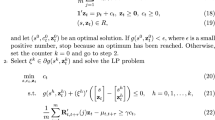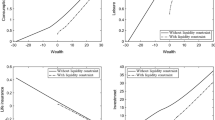Abstract
Insurance as a financial instrument has been used for a long time. The dramatic increase in competition within the insurance sector (in terms of providers coupled with awareness for the need for insurance) has concomitantly resulted in more policy options being available in the market. The insurance seller needs to know the buyer's preference for an insurance product accurately. Based on such multi-criterion decision-making, we use a logarithmic goal programming method to develop a linear utility model. The model is then used to develop a ready reckoner for policies that will aid investors in comparing them across various attributes.
Similar content being viewed by others
References
Aczel J and Saaty T (1983). Procedures for synthesizing ratio judgments . J Math Psychol 27: 93–102.
Basu S, Dutta G, Gupta R and Bhatnagar A (2004). Usage of mathematical models and operation research techniques in the insurance industry . J Ins Risk Mngt 3(5): 77–96.
Bessis J (2002). Risk Management in Banking . John Wiley & Sons Ltd: UK.
Bryson N and Joseph A (1999). Generating consensus priority point vectors: A logarithmic goal programming approach . Comput Opns Res 26: 637–643.
Cochrane JL and Zeleny M (1973). Multiple Criteria Decision Making . University of South Carolina Press: USA.
Das S (2003). Joint life insurance policies with differential benefits and premiums to the policyholders. Working Paper No. 208, Indian Institute of Management, Bangalore.
Das S and Basu S (2003). A Markov chain based no-claims discount system . J Ins Risk Mngt 2/3: 61–72.
Fourer R, Gay DM and Kernighan BW (1993). AMPL (A Modeling Language for Mathematical Programming), The Scientific Press Series . Boyd & Fraser Publishing Company: California, USA.
Green PE and Srinivasan V (1978). Conjoint analysis in consumer research: Issues and outlook . J Consum Res 5: 103–123.
Green PE and Srinivasan V (1990). Conjoint analysis in marketing: New developments with implications for research and practice . J Mark 54(4): 3–19.
India Core (2007). Overview of Insurance Sector. www.indiacore.com/insurance.html, accessed 13 March 2008.
Luce R (1959). Individual Choice Behaviour: A Theoretical Analysis . Wiley: New York.
Luce R and Suppes P (1965). Preference utility and subjective probability . In: Luce R, Bush RR and Galanter EH (eds). Handbook of Mathematical Psychology Vol. 3. Wiley: New York, pp. 249–441.
Markowitz HM (1952). Portfolio selection . J Financ 7: 77–91.
McFadden D (1980). Econometric models for probabilistic choice among products . J Bus 53(3 Part 2): S13–S29.
Saaty TL (1980). The Analytic Hierarchical Process . McGraw Hill Book Company: New York.
Srinivasan V (1980). Comments on “On conjoint analysis and quantal choice models”. J Bus 53(3 Part 2): S45–S46.
Srinivasan V (1998). A strict paired comparison linear programming approach to nonmetric conjoint analysis . In: Aronson JE and Zionts S (eds). Operations Research: Methods, Models and Applications. Quorum Books: Westport, CO, USA, pp. 97–112.
Srinivasan V, Jain AK and Malhotra NK (1983). Improving predictive power of conjoint analysis by constrained parameter estimation . J Mark Res 20: 433–438.
Author information
Authors and Affiliations
Appendices
Appendix A
Model explanation with a sample data set
In this part we explain the method using a small sample. We assume that there are eight factors and the maximum rating a respondent can assign, say, is 100, and the minimum, say, is 1.
Table A.1 shows the sample data set. The first responder's score for the factors are 85, 90, 100, 100, 95, 100, 70 and 75, respectively. Hence the values of responder 1 (t=1) for attribute 1 and 2 (or i=1 and j=2) are a 12 1=85/90=0.944. Similarly, we can find that for responder 8, a 23 8=80/60=1.333.
Based on the above mentioned method, we compute the a ij t matrix. We show part of the matrix in Table A.2.
Then we again implement equations 3 and 5 by making the transformation and putting it up in the matrix equation. We take the optimal values of w i and V i from the Excel solver, and after putting those values, we compute the values of a ij t×(v i /v j ) matrix (Table A.3).
In the next table, we show the p ij t matrix by taking care of the fact

We show p ij t matrix in Table A.4.
We do similar transformation from q ij t matrix and then we can compute the logarithmic values to get the objective function and the constraints.
We now show the optimal solution of the model with the normalized values in Table A.5.
Appendix B
Life insurance study questionnaire
Dear Sir/Madam
We are doing a study on Utility Function of Life Insurance Buyers in the Indian Institute of Management, Ahmedabad (IIMA). We would like to know the factors you would consider when choosing a life insurance policy. Filling this questionnaire should not take you more than 3 minutes.illustration

Following are some factors people consider while buying an insurance policy. Indicate the importance of each factor in influencing your decision to buy a particular life insurance policy. Indicate the importance on a scale of 1 (not at all important) to 9 (very highly important).illustration

Rights and permissions
About this article
Cite this article
Dutta, G., Basu, S. & John, J. Development of utility function for life insurance buyers in the Indian market. J Oper Res Soc 61, 585–593 (2010). https://doi.org/10.1057/jors.2009.26
Received:
Accepted:
Published:
Issue Date:
DOI: https://doi.org/10.1057/jors.2009.26




